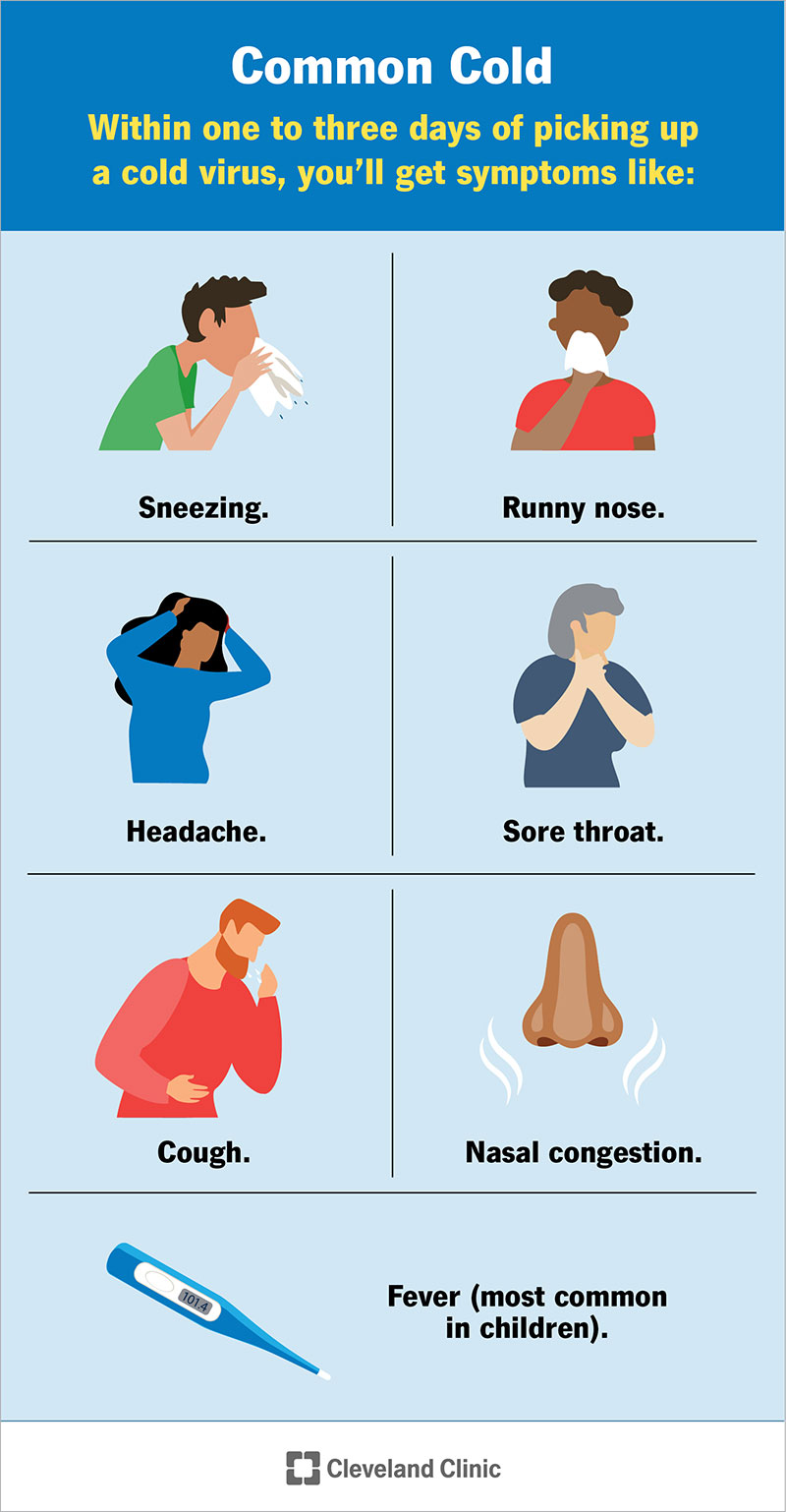What are the symptoms of the common cold?
Common cold symptoms typically appear in stages. The common cold stages include early, active and late.
Stage 1: Early (Days 1 to 3)
Within one to three days of picking up a cold virus, you may notice a tickle in your throat. About half of all people with colds report a tickly or sore throat as their first symptom. Other common cold symptoms you may experience during this early stage include:
- Sneezing.
- Runny nose.
- Stuffy nose (nasal congestion).
- Cough.
- Hoarseness.
Stage 2: Active (Days 4 to 7)
Symptoms typically worsen or peak during this stage. In addition to the symptoms in stage 1, you may experience:
- Body aches.
- Headache.
- Runny eyes and nose.
- Fatigue.
- Fever (more common in children).
Stage 3: Late (Days 8 to 10)
Colds usually begin to wind down during this stage. You may be free and clear at this point. But some symptoms can persist. Some people develop a nagging cough that can last up to two months after a respiratory infection.
If your symptoms get worse and/or your fever returns, make a trip to a healthcare provider. You may have developed another infection or a complication, such as bronchitis, sinusitis or pneumonia.
What are the symptoms of the common cold in babies?
Symptoms of colds in babies may include:
- Runny nose (the discharge may start clear; later, it becomes thicker and may be gray, yellow or green).
- Sneezing.
- Fever of 101 to 102 degrees Fahrenheit (38.3 to 38.9 degrees Celsius).
- Loss of appetite.
- Increased drooling because of sore throat and difficulty swallowing.
- Cough.
- Irritability.
- Slightly swollen glands.
How do cold symptoms differ from more severe infections in babies and children?
If your child has any of the following symptoms, call their healthcare provider. These symptoms could mean that your child has something more serious than a cold:
- Fever in an infant 2 months or younger.
- Difficulty breathing (especially if your baby’s or child’s nostrils widen with each breath).
- Fast or labored breathing.
- Wheezing.
- Ribs showing with each breath.
- Blue lips.
- Not eating or drinking, which could mean dehydration.
- Ear pain.
- Excessive crankiness or sleepiness.
- A cough that lasts more than 3 weeks.
- Your baby seems to be getting sicker.
What causes the common cold?
Rhinoviruses cause up to 50% of common colds. There are more than 100 different rhinoviruses. But other types of viruses, such as coronaviruses, can also cause colds. More than 200 different viruses can cause a cold.
Is the common cold contagious?
Yes. Colds spread easily from person to person. For you to become infected, the virus has to get to one of your mucous membranes — the moist lining of your nostrils, eyes or mouth. That happens when you touch a surface or breathe moist air that contains the cold virus.
For example, when a person who’s sick sneezes or coughs, they launch droplets of fluid containing the cold virus into the air. If you breathe in those droplets, the cold virus takes root in your nose. You can also leave virus particles on surfaces you touch when you’re sick. If someone else touches those surfaces and then touches their nostrils, eyes or mouth, the virus can get in.
How long is the common cold contagious?
You can be contagious for up to two weeks, even spreading a cold a day or two before you have symptoms. But you’re most contagious when your symptoms are at their worst — usually the first three days you feel sick.
What is the common cold incubation period?
The incubation period is the time between when you’re infected and when your symptoms first appear. The common cold incubation period is between 12 hours and three days after exposure to the virus.
Why do children and babies get more colds?
The common cold in children and babies occurs more often because they haven’t been exposed to as many viruses as adults. Their immune systems have to learn how to recognize and fight new germs.
Before turning 2 years old, a baby can get as many as eight to 10 colds a year. By the time you become an adult, you’ve had many colds. It’s easier for your immune system to identify and attack similar viruses.
In addition, children are in close contact with other children. Kids typically don’t cover their coughs and sneezes or wash their hands before touching their faces — steps that prevent the virus from spreading.
Cold viruses can live on objects for several hours. Babies often pick up objects that other babies have touched. If a baby touches something that has cold germs on it, then touches their mouth, eyes or nose, the germs can infect them.
link

